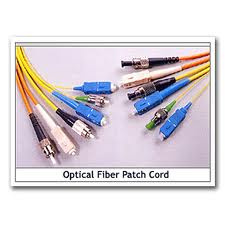MULTI MODE FIBER CABLE
has a little bit bigger diameter, with a common diameters in the 50-to-100 micron range for the light carry component (in the US the most common size is 62.5um). Most applications in which Multi-mode fiber is used, 2 fibers are used (WDM is not normally used on multi-mode fiber). POF is a newer plastic-based cable which promises performance similar to glass cable on very short runs, but at a lower cost. Multimode fiber gives you high bandwidth at high speeds (10 to 100MBS - Gigabit to 275m to 2km) over medium distances. Light waves are dispersed into numerous paths, or modes, as they travel through the cable's core typically 850 or 1300nm. Typical multimode fiber core diameters are 50, 62.5, and 100 micrometers. However, in long cable runs (greater than 3000 feet [914.4 meters), multiple paths of light can cause signal distortion at the receiving end, resulting in an unclear and incomplete data transmission so designers now call for single mode fiber in new applications using Gigabit and beyond. The applications of optical fiber communications have increased at a rapid rate, since the first commercial installation of a fiber-optic system in 1977. Telephone companies began early on, replacing their old copper wire systems with optical fiber lines. Today's telephone companies use optical fiber throughout their system as the backbone architecture and as the long-distance connection between city phone systems. Cable television companies have also began integrating fiber-optics into their cable systems. The trunk lines that connect central offices have generally been replaced with optical fiber. Some providers have begun experimenting with fiber to the curb using a fiber/coaxial hybrid. Such a hybrid allows for the integration of fiber and coaxial at a neighborhood location. This location, called a node, would provide the optical receiver that converts the light impulses back to electronic signals. The signals could then be fed to individual homes via coaxial cable. Local Area Networks (LAN) is a collective group of computers, or computer systems, connected to each other allowing for shared program software or data bases. Colleges, universities, office buildings, and industrial plants, just to name a few, all make use of optical fiber within their LAN systems. Power companies are an emerging group that have begun to utilize fiber-optics in their communication systems. Most power utilities already have fiber-optic communication systems in use for monitoring their power grid systems. Fiber Some 10 billion digital bits can be transmitted per second along an optical fiber link in a commercial network, enough to carry tens of thousands of telephone calls. Hair-thin fibers consist of two concentric layers of high-purity silica glass the core and the cladding, which are enclosed by a protective sheath. Light rays modulated into digital pulses with a laser or a light-emitting diode move along the core without penetrating the cladding. The light stays confined to the core because the cladding has a lower refractive index—a measure of its ability to bend light. Refinements in optical fibers, along with the development of new lasers and diodes, may one day allow commercial fiber-optic networks to carry trillions of bits of data per second. Total internal refection confines light within optical fibers (similar to looking down a mirror made in the shape of a long paper towel tube). Because the cladding has a lower refractive index, light rays reflect back into the core if they encounter the cladding at a shallow angle (red lines). A ray that exceeds a certain "critical" angle escapes from the fiber (yellow line). STEP INDEX MULTIMODE FIBER has a large core, up to 100 microns in diameter. As a result, some of the light rays that make up the digital pulse may travel a direct route, whereas others zigzag as they bounce off the cladding. These alternative pathways cause the different groupings of light rays, referred to as modes, to arrive separately at a receiving point. The pulse, an aggregate of different modes, begins to spread out, losing its well-defined shape. The need to leave spacing between pulses to prevent overlapping limits bandwidth that is, the amount of information that can be sent. Consequently, this type of fiber is best suited for transmission over short distances, in an endoscope, for instance. SINGLE-MODE FIBER has a narrow core (eight microns or less), and the index of refraction between the core and the cladding changes less than it does for multimode fibers. Light thus travels parallel to the axis, creating little pulse dispersion. Telephone and cable television networks install millions of kilometers of this fiber every year. Loose-Tube Cable CLTIn a loose-tube cable design, color-coded plastic buffer tubes house and protect optical fibers. A gel filling compound impedes water penetration. Excess fiber length (relative to buffer tube length) insulates fibers from stresses of installation and environmental loading. Buffer tubes are stranded around a dielectric or steel central member, which serves as an anti-buckling element.The cable core, typically uses aramid yarn, as the primary tensile strength member. The outer polyethylene jacket is extruded over the core. If armoring is required, a corrugated steel tape is formed around a single jacketed cable with an additional jacket extruded over the armor. Loose-tube cables typically are used for outside-plant installation in aerial, duct and direct-buried applications. Tight-Buffered CableWith tight-buffered cable designs, the buffering material is in direct contact with the fiber. This design is suited for "jumper cables" which connect outside plant cables to terminal equipment, and also for linking various devices in a premises network.Multi-fiber, tight-buffered cables often are used for intra-building, risers, general building and plenum applications. The tight-buffered design provides a rugged cable structure to protect individual fibers during handling, routing and connectorization. Yarn strength members keep the tensile load away from the fiber. As with loose-tube cables, optical specifications for tight-buffered cables also should include the maximum performance of all fibers over the operating temperature range and life of the cable. Averages should not be acceptable. Connector Types fiber cable out and in types
|














































